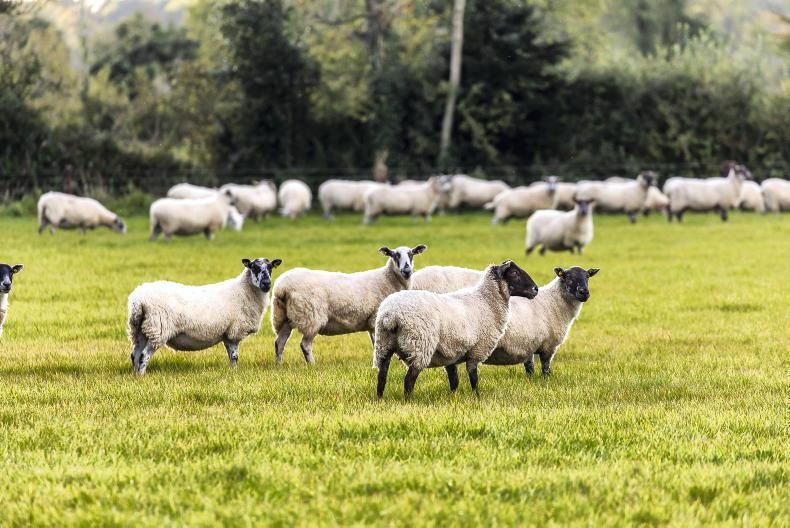The results of recent scanning on Tullamore Farm have failed to reach the high bar set in previous years.
The low point of this year’s scanning was 17 empty ewes from 163 put to the ram or a barren rate of 10.4%.
This compares with a barren rate of 2% to 3% in recent years.
The most frustrating element is trying to establish what may have contributed to the higher barren rate, with all bases well covered by farm manager Shaun Diver.
The obvious area where problems occur is in ram infertility or subfertility
Ewes were all condition scored in advance of breeding as part of the flock recording performance with Sheep Ireland, with all ewes in optimum condition.
Nutrition was more than adequate in the run-up, during and after mating, with no signs identified by the scanning operator of any recent embryo loss.
The obvious area where problems occur is in ram infertility or subfertility. The farm practised single-sire mating again last autumn and this was one of the first areas raised as a contributor.
Ewes were also raddled between cycles and there was no spike in repeat activity that would have raised any concerns
Rams were switched between groups after the first cycle to reduce the consequences of a breakdown in ram fertility, while all ewes and rams were batched together for the third breeding cycle.
Ewes were also raddled between cycles and there was no spike in repeat activity that would have raised any concerns.
Shaun has also cross-referenced ewes that are barren with breeding groups and there is nothing out of the ordinary showing up in any one group. This does not eliminate ram sub-fertility from contributing to the lower scanning rate.
Barren ewes
The only aspect Shaun uncovered is a higher cohort of barren ewes being 2018-born, with six out of the 17 in this bracket. He recorded difficult lambings in these hogget ewes in spring 2020, so that could be a possible cause. However, it does not explain the rest, with ages broken down into one 2013-born ewe and two ewes born in each of 2014, 2015, 2016, 2017 and 2019. Another train of thought pointed to the potential of toxoplasmosis or an essential element mineral deficiency. All ewes are vaccinated for toxoplasmosis and enzootic abortion, while ewes also received a mineral drench pre-breeding.
Irish Country Meats facilitated the collection of some liver and kidney samples in barren ewes which were slaughtered last week
To explore these avenues further, the farm’s vet Donal Lynch collected a number of blood samples which have been sent for analysis. Irish Country Meats facilitated the collection of some liver and kidney samples in barren ewes which were slaughtered last week and these are currently being analysed to determine mineral status in Kilkenny Regional Veterinary Laboratory. The results of these tests will be published as they become available, along with any other findings.
Slaughter performance
While on the subject, the 17 Mule ewes achieved an average carcase weight of 35.7kg. At a price of €3/kg when marketed through the Offaly Quality Lamb Producer Group, they grossed €107.14.
As continues to be the case, there is a large differential between ewe liveweights, with the carcase weight ranging in general from 33kg to 37kg, with three ewes killing at 42.9kg, 44.2kg and 46.4kg carcase weight, while the three lightest ewes ranged from 29.2kg to 32.5kg.
Litter size
The overall scanning rate including barren ewes was 1.69 lambs per ewe joined and the in-lamb rate was 1.88 lambs. This is also significantly lower than the scanning rate of 2.12 lambs per ewe joined in 2019/2020, so it will be interesting to see if there is any outcome in mineral analysis.
It is likely though that the lower in-lamb rate is resulting partly from a younger flock age profile, with hard culling of the original flock in 2020, and partly from aged ewes not repeating the high performance of recent years with an in-lamb rate of 1.88 lambs.
Ewe lambs
There were 19 ewe lambs scanned empty from 79 put to the ram (24%), which was slightly higher than targeted but also explained by a three-week breeding period.
The scanning rate was recorded at 0.99 lambs per ewe lamb joined with an in-lamb rate of 1.3 lambs. Fourteen of the 41 Mule ewe lambs were empty, with many of these late-2021 born and likely requiring a longer breeding season or to be mated later in the year.






 This is a subscriber-only article
This is a subscriber-only article










SHARING OPTIONS: